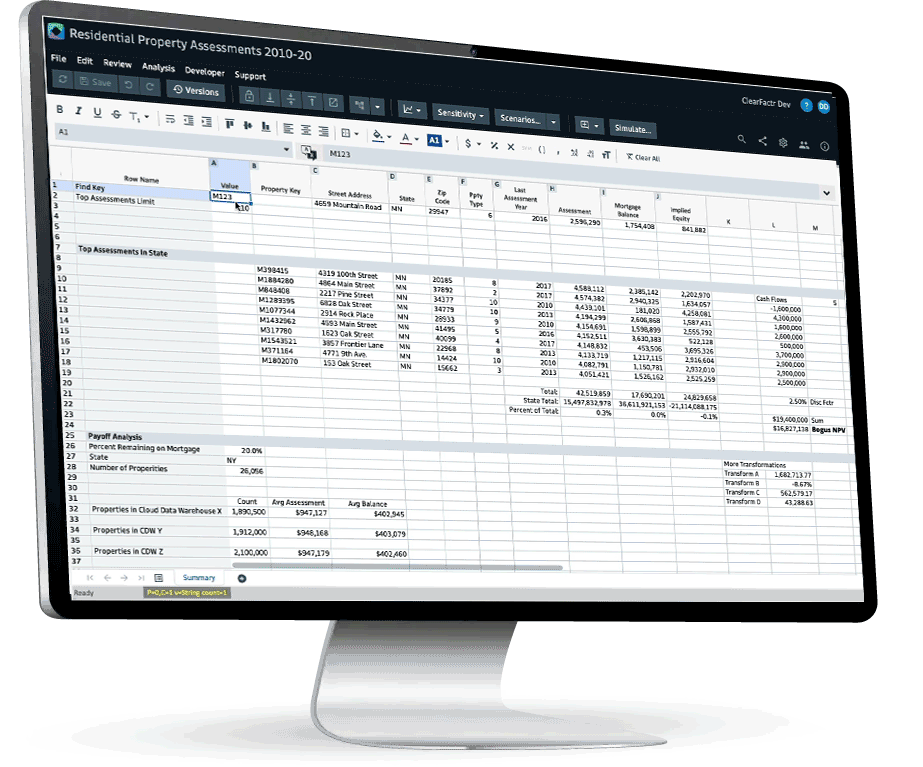
 Written by: Dean Zarras
Written by: Dean Zarras
To understand the potential impact of ClearFactr's CFSQL functionality, one must look back at the history of the spreadsheet itself, and what it allowed for.
Prior to the spreadsheet, if a person wanted to create some kind of mathematical model or explanation, they had two choices: run the numbers by hand with a calculator, pencil and paper, or seek the assistance of their company's IT Department. If the amount of calculation required was anything significant, doing something by hand wasn't likely an option, but even if it was, changing a single number or relationship between two or more numbers potentially meant doing everything over.
In either case, doing something once and then sharing the results with an audience meant printing things out and distributing them, and then if anyone in the audience questioned anything or sought any changes, the entire process would repeat again.
If the person did have the IT Department's attention (and corresponding budget!), both the data and the relationships between the pieces of the data needed to be programmed and stored. Cycle-times on even a minimal change might require hours at best, if not days or weeks.
Continuing down the computerized route, doing any of this outside of the office was effectively impossible until the birth of the personal computer. Paired with spreadsheet software, the combination represented a never-before-seen empowerment of the individual for mathematically-driven problem-solving, and for thought itself. It's hard to overstate the impact.
But the moment the spreadsheet was capable of storing a meaningful amount of data, combined with the emergence of macro-languages and presentation capabilities beyond the grid itself, what the user had in their hands was a personal application/solution building device.
At this juncture, in some ways, the IT Department was inevitably doomed. Its processes for creating and deploying solutions were no match for the ability of a single smart individual and their spreadsheet to produce and maintain something "good enough" for the moment's need. And as PC's proliferated, as fast as the spreadsheet creator could issue a "Save As" or File Copy command, their "good enough" solution could potentially meet the needs of their entire department, let alone satisfy or even invent entire new workflows between individuals.
But who had the right data? And who had the latest version of the "data processing", perhaps the one with the corrected-calculation, fixed late at night by a teammate in the group, passed on to some people, but not to everyone, unbeknownst to some...
Fast forward many years, and networked PC's, "CSV Import", form builders, email and gorgeous presentation capabilities only conspired to elevate even further what that single smart individual could produce.
Where a group of users might have wanted a well thought out, reliable solution to their needs -- a custom application, built and maintained by the IT department -- that same smart individual might still run rings around them, for an apparent fraction of the cost. "Apparent", because the operational risks embedded in the spreadsheet-based workflows were never fully priced.
Internet-based spreadsheets like ClearFactr now have the potential to tame the management and distribution of computing logic. A single spreadsheet document containing data-processing logic can be shared and leveraged by a group of individuals. The processing logic can be seen, debated and refined by various stakeholders. Opportunities for rapid iteration and improvement along with better and more effective decision-making are presented.
But as the world's ability to generate previously-unthinkable amounts of data continues to accelerate via ever-plummeting costs, getting people access to that data in a way that they could quickly experiment and operate on it -- without custom software, and without the operational risks of attempting to maintain it -- remains elusive. Large amounts of data remain ensconced in corporate databases -- where it belongs -- but the cycle-times to iterate around solutions driven by that data remain painstakingly long for end users.
Recall that the entire intent of a database is to collect, safe-guard, and leverage data, and the potential value rises with the quantity. Very notably, however, the data itself "just sits there." Other processes need to exist to read, analyze, interpret and possibly modify that data, so that individuals can act on it. A single, well-architected database along with the associated management processes can serve a multitude of needs. As it does, operating leverage increases and organizational effectiveness increases in parallel.
Organizations need to leverage their databases, because the alternative is rampant inefficiency and risk.
ClearFactr's CFSQL capability combines the computational productivity capabilities of a spreadsheet with the properly safe-guarded, scalable, and centralized capabilities of a true database to usher in a new form of solution-building.
Why is this a big deal? Because most spreadsheet users never asked for a spreadsheet -- they ideally wanted a custom application instead. ClearFactr's combination of end-user-visible calculation logic, the ability to experiment with that logic, and now the ability to drive it with unlimited amounts of data -- properly managed and scaled independently -- can represent a new toolkit for solution providers.
Databases have their own languages, such as SQL, developed over decades to meet the needs of finding, analyzing and maintaining the very large amounts of data they have always been capable of handling. Any attempt to replicate these capabilities without using these languages requires the creation of an entirely new grammar, which quickly becomes an unproductive exercise, crippling CFSQL's potential.
Attempts at doing this actually exist within the spreadsheet developer's lexicon: odd, often replicated combinations of data-consuming Excel functions such as SUMIFS, COUNTIFS, VLOOKUP, HLOOKUP, INDEX, MATCH and many others. When copied over sometimes many thousands of cells, and possibly driven by countless thousands more, it's no wonder that so many of today's otherwise valuable "spreadsheet apps" grind to a halt. In some situations, a single SQL statement could perform the intended work of thousands of Excel formulas, if even possible in Excel at all.
But a potential CFSQL implementation obstacle exists: the "spreadsheet developer" may not know the language of the databases that should be driving their solutions.
Properly leveraging CFSQL represents nothing less than an opportunity for "the IT Department" -- in this case, data engineers -- to re-insert themselves on the front-line as a facilitator of custom solutions with the rapidity that end-users have always sought.
The breakthrough of CFSQL is the ease at which the solution builder(s) can combine the computational logic of the model with the vast amounts of data housed in the database; driving the database queries and analytics based on values within the model, returning results back to the model, and then possibility repeating this cycle along any number of branches within an arbitrarily complex calculation graph.
The combination of the financial engineer to program the computational logic of the spreadsheet, with the data engineer to architect the proper backing data models, can be leveraged together by ClearFactr as a solution delivering platform. Both aspects -- computational and data processing logic -- can be further supplemented by ClearFactr's APIs. Additional orders of magnitude of leverage can be achieved by placing the entire solution within one or more larger-scale integrations.
Altogether, is win-win-win: for the solution builders, for the solution users, and at scale, for the entire firm. Better yet, it creates acceleration, where yesterday's wins become the starting points for tomorrow's -- also known as Software Capital.
Tags: Product Features

This post is a precursor to a series of posts, two of which are being released simultaneously. It's the necessary backstory to the series. Over a year ago I came up with two diagrams that describe...

You asked, and we've responded... Watch ClearFactr come to life in first of a series of product demo videos. Not quite as impactful as a live demo tailored to your own situation (make that happen,...
